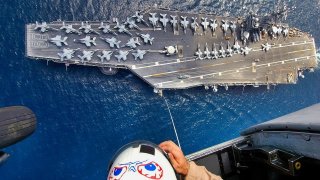U.S. Navy Aircraft Carrier USS Dwight D. Eisenhower Is Ready for Anything
The aircraft carrier USS Dwight D. Eisenhower (IKECSG), along with her carrier strike group, recently transitioned to the U.S. 6th Fleet's area of operations in the Eastern Mediterranean, following a five-month deployment under the U.S. 5th Fleet.
Summary: The aircraft carrier USS Dwight D. Eisenhower (IKECSG), along with her carrier strike group, recently transitioned to the U.S. 6th Fleet's area of operations in the Eastern Mediterranean, following a five-month deployment under the U.S. 5th Fleet.
-This move showcases the strategic mobility and combat capabilities of the U.S. Navy, allowing for enhanced maritime flexibility and operational reach. The strike group, which includes the Arleigh Burke-class destroyer USS Gravely, has been actively involved in operations ranging from maritime security in the Red Sea to engaging threats in Yemen.
-The Eisenhower, a Nimitz-class supercarrier slated for replacement by the USS Enterprise in 2029, continues to play a crucial role in U.S. naval operations across multiple regions.
USS Dwight D. Eisenhower Bolsters U.S. Naval Power in the Eastern Mediterranean
The United States Navy's Nimitz-class supercarrier USS Dwight D. Eisenhower, along with her carrier strike group (IKECSG) arrived in the Eastern Mediterranean last week as part of a pre-announced Department of Defense deployment. The nuclear-powered flattop was accompanied by the Arleigh Burke-class guided-missile destroyer USS Gravely (DDG 107) through the Suez Canal.
CSGs bring to the region additional aviation and surface assets, providing greater flexibility and maritime capability to the U.S. 6th Fleet, the U.S. Navy announced.
"The Dwight D. Eisenhower Carrier Strike Group has delivered exceptional naval power in the U.S. 5th Fleet for the last five months," said Rear Adm. Marc Miguez, commander, CSG-2, IKECSG. "Reentry into the U.S. 6th Fleet is only a small gesture of our ability to project combat superiority to any part of the globe."
IKECSG units departed their homeports of Norfolk, Virginia, and Mayport, Florida, on Oct. 13 & 14 for a scheduled deployment to the region, and since last fall conducted operations as part of the U.S. 5th Fleet in the Red Sea, Bab Al-Mandeb Strait, Gulf of Aden and Arabian Gulf including Operation Prosperity Guardian and self-defensive strikes into Iranian-backed Houthi-controlled areas of Yemen.
The strike group is commanded by Carrier Strike Group (CSG) 2 and comprised of flagship USS Dwight D. Eisenhower, Carrier Air Wing (CVW) 3 with its nine squadrons, USS Philippine Sea (CG 58), and Destroyer Squadron (DESRON) 22, with the guided-missile destroyers USS Gravely (DDG 107) and USS Mason (DDG 87).
The departure of the IKECSG from the Red Sea was noted by Houthi leader Abdul-Malik Badruldeen al-Houthi.
“The American naval presence has shrunk, and many of its warships have disappeared and have spread to the outskirts of the Red Sea," Badruldeen al-Houthi wrote on the Telegram social messaging app according to a report from USNI News.
Meet the Ike
USS Dwight D. Eisenhower (CVN-69) is the second oldest nuclear-powered aircraft carrier in service in the world today. It is currently scheduled to be replaced around 2029 when the new Gerald R. Ford -class supercarrier USS Enterprise (CVN-80) enters service.
Named to honor the 34th president of the U.S. and General of the Army, the aircraft carrier has remained in service for more than four decades. Congress authorized CVN-69 in 1970, which it later commissioned seven years later. Following more than a year of fleet training, Ike was deployed to the Mediterranean. The mighty shift underwent a major overhaul to be fitted with newer technology in the mid-1980s and was later released back into the waters by 1987.

Over its lengthy service history, the USS Dwight D. Eisenhower has been deployed to a litany of combat operations. The ship’s first deployment was dubbed Operation Eagle Claw during the 1980 Iran hostage crisis. One of the carrier's most notable deployments took place during Iraq's invasion of Kuwait in 1990, and it was during that deployment that she became the second nuclear-powered carrier ever to transit the Suez Canal – making this recent transit back to the Mediterranean all the more noteworthy.
Author Experience and Expertise: Peter Suciu
Peter Suciu is a Michigan-based writer. He has contributed to more than four dozen magazines, newspapers, and websites with over 3,200 published pieces over a twenty-year career in journalism. He regularly writes about military hardware, firearms history, cybersecurity, politics, and international affairs. Peter is also a Contributing Writer for Forbes and Clearance Jobs. You can follow him on Twitter: @PeterSuciu. You can email the author: [email protected].


